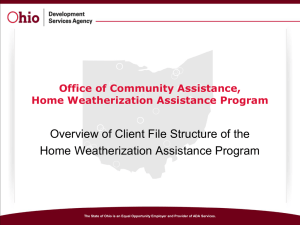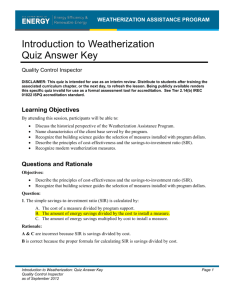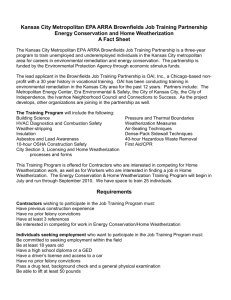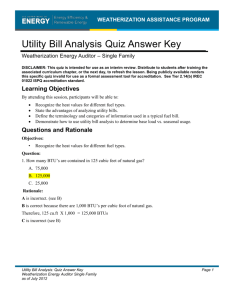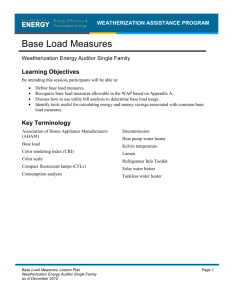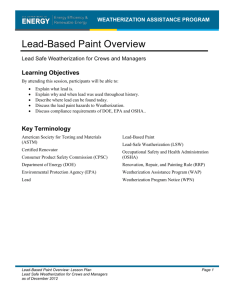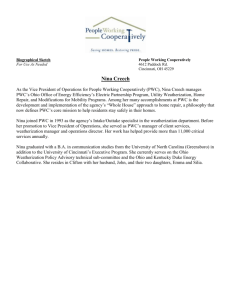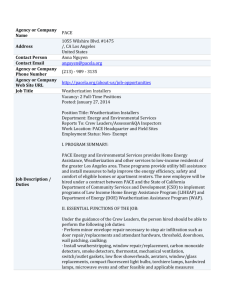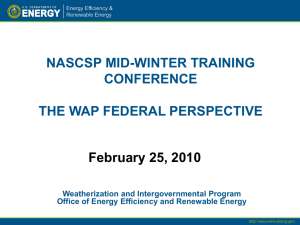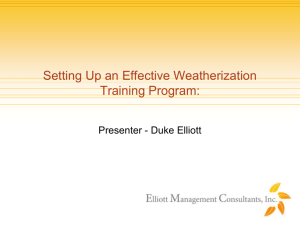Technical Advancements - Weatherization Assistance Program
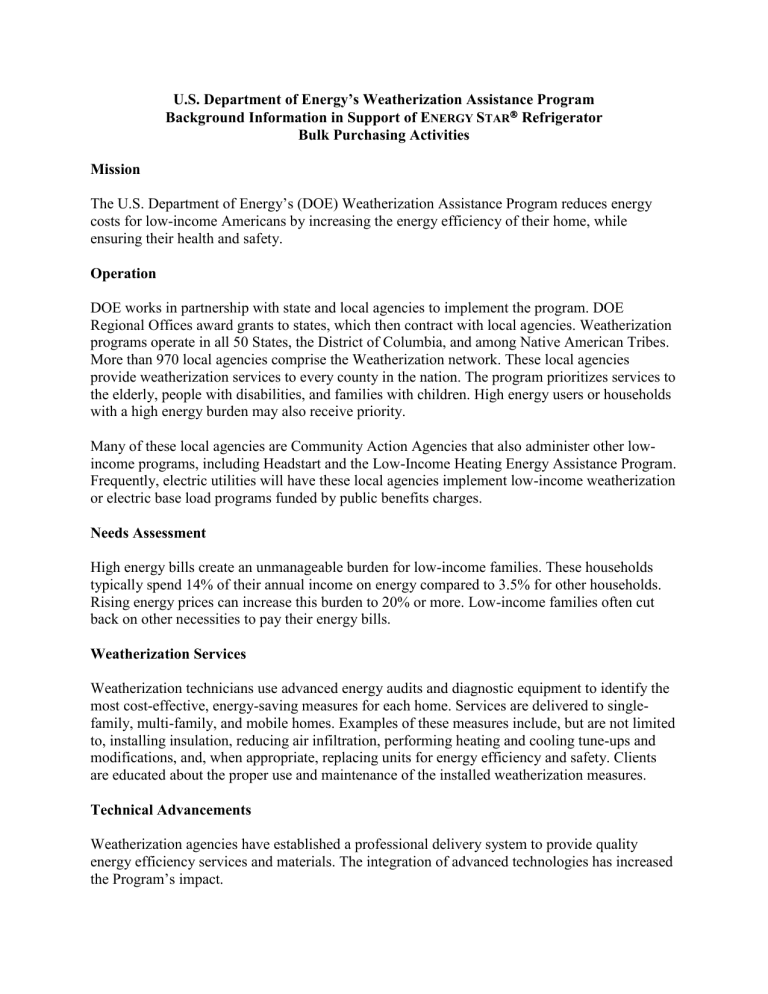
U.S. Department of Energy’s Weatherization Assistance Program
Background Information in Support of E
NERGY
S
TAR
Refrigerator
Bulk Purchasing Activities
Mission
The U.S. Department of Energy’s (DOE) Weatherization Assistance Program reduces energy costs for low-income Americans by increasing the energy efficiency of their home, while ensuring their health and safety.
Operation
DOE works in partnership with state and local agencies to implement the program. DOE
Regional Offices award grants to states, which then contract with local agencies. Weatherization programs operate in all 50 States, the District of Columbia, and among Native American Tribes.
More than 970 local agencies comprise the Weatherization network. These local agencies provide weatherization services to every county in the nation. The program prioritizes services to the elderly, people with disabilities, and families with children. High energy users or households with a high energy burden may also receive priority.
Many of these local agencies are Community Action Agencies that also administer other lowincome programs, including Headstart and the Low-Income Heating Energy Assistance Program.
Frequently, electric utilities will have these local agencies implement low-income weatherization or electric base load programs funded by public benefits charges.
Needs Assessment
High energy bills create an unmanageable burden for low-income families. These households typically spend 14% of their annual income on energy compared to 3.5% for other households.
Rising energy prices can increase this burden to 20% or more. Low-income families often cut back on other necessities to pay their energy bills.
Weatherization Services
Weatherization technicians use advanced energy audits and diagnostic equipment to identify the most cost-effective, energy-saving measures for each home. Services are delivered to singlefamily, multi-family, and mobile homes. Examples of these measures include, but are not limited to, installing insulation, reducing air infiltration, performing heating and cooling tune-ups and modifications, and, when appropriate, replacing units for energy efficiency and safety. Clients are educated about the proper use and maintenance of the installed weatherization measures.
Technical Advancements
Weatherization agencies have established a professional delivery system to provide quality energy efficiency services and materials. The integration of advanced technologies has increased the Program’s impact.
Results:
• Advanced energy audits used to determine most cost-effective measures;
•
Blower-door directed air sealing produces higher energy savings;
•
Weatherization creates $2.10 in energy-related benefits for every $1 invested.
Allowable Weatherization Measures
Only materials that are listed in Appendix A of the regulations governing the program (10 CFR
440) may be purchased with DOE funds. These materials include:
•
Insulation
• Caulks, sealants, & weatherstripping
•
Boiler, furnace, heat pump, and air
•
Replacement windows and doors
• Storm windows and doors
•
Solar films and screens, awnings, and conditioner repair parts, controls, and energy conserving devices
•
Replacement boilers, furnaces, heat pumps, wood stoves, and air conditioners
• Water heater insulation, repair parts, and energy-conserving devices
•
Replacement water heaters louvers to shade windows
• Insect screens (to allow natural ventilation in lieu of mechanical air conditioning)
•
White reflective roof coating
• Miscellaneous repair materials
•
Refrigerators
•
CFLs and fluorescent fixtures
Electric Base Load Measures
While CFLs and fluorescent light fixtures have been allowed for some time, refrigerators have only recently been added to the program (December 2000). Water heater modifications such as insulation, heat traps, and vent dampers have been allowable since the inception of the program, but replacement water heaters were added to the program at the same time refrigerators were allowed.
Refrigerators: Refrigerators that may be purchased with DOE funds include refrigerators and refrigerator-freezers with manual, partial automatic, and fully automatic defrost. Top freezer, bottom freezer, and side-by-side configurations are allowed. DOE funds may not be used to purchase units with through-the-door ice or water service since this feature can increase energy use by about 12%. The cost-effectiveness calculation (see below) must include the cost of removing the old refrigerator and de-manufacturing it in an environmentally responsible manner in compliance with the Clean Air Act.
Upright and chest freezers are not allowable Weatherization measures. However, two-for-one replacements that include an existing freezer are allowed. For example, a low-income client has a 18-cubic-foot refrigerator-freezer and a 12-cubic-foot upright freezer. With the agreement of the client, a Weatherization agency may remove both units and install a new
25-cubic-foot refrigerator-freezer provided the swap results in a savings-to-investment ratio of 1.0 or greater (see Cost-Effectiveness Requirements below).
Cost-Effectiveness Requirements
Individual Weatherization measures must have a savings-to-investment ratio (SIR) of 1.0 or greater. This means that the energy cost savings for the life of the measures, discounted to present value, must meet or exceed the cost to install the measure including labor, materials, and on-site supervisory personnel. The DOE discount rate (published annually by NIST for use in
DOE’s FEMP) should be used to discount the value of energy cost savings in future years, together with reasonable assumptions regarding measure lifetimes. States may leave the discount rate unchanged for up to five years.
The overall SIR for the package of Weatherization measures installed in a dwelling must also be greater than or equal to one. The overall SIR for the entire package of measures differs from the aggregate of the SIRs of all the individual measures in that the overall SIR must include the cost of incidental repairs that the dwelling may require. Note that incidental repairs are limited to those items that must be repaired because of the installation of Weatherization measures or to ensure their effectiveness (e.g., limited repair of roof leaks before attic insulation can be installed).

